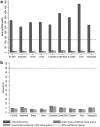Total and whole grain intake in Latin America: findings from the multicenter cross-sectional Latin American Study of Health and Nutrition (ELANS)
- PMID: 34232375
- PMCID: PMC8783851
- DOI: 10.1007/s00394-021-02635-8
Total and whole grain intake in Latin America: findings from the multicenter cross-sectional Latin American Study of Health and Nutrition (ELANS)
Erratum in
-
Correction to: Total and whole grain intake in Latin America: fndings from the multicenter cross-sectional Latin American Study of Health and Nutrition (ELANS).Eur J Nutr. 2022 Feb;61(1):503-504. doi: 10.1007/s00394-021-02723-9. Eur J Nutr. 2022. PMID: 34748061 Free PMC article. No abstract available.
Abstract
Purpose: Understanding whole-grain intake and its associated factors is essential to tackle the double burden of malnutrition faced by Latin American countries. This study aimed to characterize total and whole grain intake in Latin American countries and to investigate foods contributing to these intake in the region.
Methods: Data were obtained from the multicenter cross-sectional survey Latin American Study of Nutrition and Health (ELANS), including 9128 participants residing in urban areas of eight Latin American countries. Data collection was performed via two household visits using a standardized questionnaire and two 24 h dietary recalls. Usual dietary intake of total grain foods and foods containing whole grains was estimated. The association between the intake of grain food groups and sociodemographic variables was investigated using multiple linear regression models with random intercepts.
Results: Mean intake of total grain foods and foods containing whole grains was 318.6 g/d and 14.7 g/d, respectively. Total grain foods were less consumed by participants at older ages (-9.8 g/d), and females (-9.9 g/d), and more consumed by those in the lowest socioeconomic category (24.8 g/d). Foods containing whole grains were more consumed by participants at older ages (3.3 g/d), and females (4.0 g/d), while those in the lowest socioeconomic category consumed 2.9 g/d less. Major contributors to energy provided from foods containing whole grains were oatmeal, masa harina, whole-wheat bread, corn chips, and wheat crackers.
Conclusion: The intake of grain foods represented a substantial part of the Latin American population's diet, but the intake of foods containing whole grains was extremely low in all assessed countries.
Keywords: Dietary intake; Epidemiology; Latin America; Multicenter study; Socioeconomic factors; Whole grain.
© 2021. The Author(s).
Conflict of interest statement
This manuscript presents independent research. The views expressed in this publication are those of the authors and not necessarily those of the acknowledged institutions. The funding sponsors had no role in study design; the collection, analyses, or interpretation of data, writing of the manuscript, or in the decision to publish the results.
Figures



References
Publication types
MeSH terms
LinkOut - more resources
Full Text Sources

